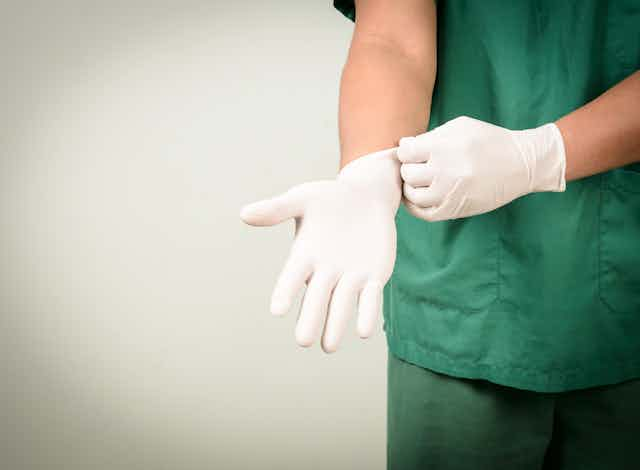Three prime ministers and nearly three years ago, “first bloke” Tim Mathieson caused a brouhaha with his advice on prostate cancer screening:
We can get a blood test for it, but the digital examination is the only true way to get a correct reading on your prostate, so make sure you go and do that, and perhaps look for a small Asian female doctor is probably the best way.
It was the “small Asian female” part of this statement that attracted criticism, but what of the rest of his advice?

It correctly identifies the two common ways GPs screen for prostate cancer: a blood test (for a protein called prostate-specific antigen, or PSA) and the digital rectal examination, in which a doctor feels the prostate gland by inserting a gloved finger (“digit”) into a man’s rectum.
But rectal examination is less accurate than the PSA blood test, missing more cancer and causing more false alarm.
Until recently, the combination of PSA and rectal examination was recommended. If the PSA level is too high, or the prostate feels suspiciously abnormal, men usually go to get a biopsy to see if there is truly cancer in the prostate.
In news that may come as a relief to apprehensive men and short-fingered doctors alike, guidelines are changing. Both the Cancer Council and the Royal Australian College of General Practitioners have recently recommended doctors dispense with the rectal examination when screening for prostate cancer.
What is prostate cancer screening?
The prostate is a gland at the base of the male bladder which wraps itself around the beginning of the urethra (the urine outflow tube). Though small, it can cause big problems for men’s well-being. Prostate cancer is the fourth leading cause of death in Australian men, after heart attacks, lung cancer and stroke.
By “screening”, we mean doing tests that look for prostate cancer in men who are at low risk – those with no family history of prostate cancer. (The situation is more complicated for men with such family history; I won’t discuss this here.) This screening is most often considered for men aged 50-69.
The hope with cancer screening is that, by picking up cancer early, we may forestall death and avoid suffering. But for prostate cancer, our screening tests (PSA and rectal examination) have significant limitations.
Should you choose to be screened for prostate cancer at all?
Prostate cancer is a disease that many men die with rather than of – that is, despite aggressive prostate cancer killing some men, many more men would peacefully co-exist with their mild prostate cancers if they were left undiscovered.
Detecting prostate cancer might do good if it allows timely treatment to save men’s lives, but can do harm via treatment side-effects: impotence, incontinence, the anxiety of false alarms or of discovering cancer, and so on.
Whether prostate screening saves lives at all is still debated. Several trials have found no preventive effect. The best-conducted trial (probably our most reliable) showed that screening could prevent about one in five deaths from prostate cancer. However, this protection doesn’t happen very often.
For a useful illustration, see the second page of this information sheet. This shows that over 11 years, about 1,000 men must be screened (with PSA with or without rectal examinations) to save one life. In saving this one life, the trade-offs include:
- scores of men will have to undergo a prostate biopsy (passing a needle into the prostate several times via the rectum, and getting samples to be examined under a microscope)
- several will have complications of this biopsy
- about 37 extra men will find out they have prostate cancer (many of whom would not have suffered if the cancer was undetected)
- several will suffer cancer treatment side effects such as impotence or incontinence.

How should we weigh up these pros and cons?
For some men, the small chance of benefit and the larger risk of harm leads them to decide not to proceed with testing. For others, the possibility of averting a cancer death, though small and uncertain, is worth the risks.
There’s no right or wrong answer about whether to screen – it’s a value judgement. Doctors should share good information with their patients and help men make a decision in keeping with their own preferences.
If you do choose screening, should you have a rectal examination?
Doctors have a hackneyed saying about rectal examinations: “if you don’t put your finger in it, you’ll put your foot in it”.
The point is that we can miss important things by not doing a rectal examination. This can be true for some people with symptoms, such as rectal bleeding. But on balance, it seems it’s not the case for prostate cancer screening.
We need to decide where to set the threshold for what is considered normal for diagnostic tests. This is the case for the PSA blood test, where traditionally we use a cut-off of four nanograms per millilitre (4ng/ml) as dividing normal from abnormal (though some studies used a cut-off of 3ng/ml).
Set the cut-off too low, close to zero, and we’ll send nearly all men for biopsies that are largely unnecessary. Set the cut-off too high and we’ll miss many prostate cancers. Unfortunately, there’s no magic threshold that perfectly divides the men with the cancers we want to catch from the men we needn’t trouble.
Does the digital rectal examination improve matters when added to the PSA test? Not really. The rectal examination does pick up slightly more cancers, but these seem to be mostly the less aggressive cancers, less likely to be the ones we need worry about. In doing so, it causes more false alarms, by creating two or more false positive results for every cancer found.
The right balance between detection and false alarm is again a value judgement. But, critically, we can achieve the same sort of pick-up of cancers that we get from adding a rectal examination just by changing our PSA threshold from 4ng/ml to 3ng/ml.
Why would we want to perform an examination that many men find unpleasant when we could instead simply interpret the blood test a little differently?
As a GP, I’m following the new guidelines and not routinely performing screening rectal examinations any more.
No doubt some men will expect an examination, perhaps due to tradition, or fear of missing things. If so, I will go ahead with the examination if they prefer. But first I’ll make sure I discuss all the pros and cons – first of screening at all, and then of the limited additional value of the rectal examination.
It’ll be good to be able to reassure many men that screening rectal examinations are no longer the norm.

